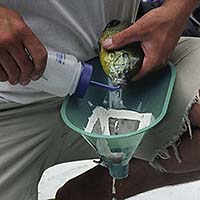Dances with Dragonflies: Agile Insect a Signal of Shoreline Health
You Want Broccoli with that Steak?
“Can you believe we get paid to do this?”
Drifting in a small boat around Crampton Lake, doctoral student Chris Solomon warms his face in the early morning light. Dense woods drape the lake’s sparkling waters, which mirror a piercing blue sky. Loons glide silently past and fish ripple at the water’s surface.
The meditative start to the morning is one of Solomon’s daily rituals—and one that serves a critical part of an unprecedented UW-Madison study.

On the banks of Crampton Lake doctoral student Chris Solomon prepares for his daily drop of Carbon-13.
About 40 minutes by road from Trout Lake Station, the 74-acre Crampton Lake, is one of 28 protected lakes owned by the University of Notre Dame Ecological Research Center (UNDERC). UW-Madison ecologists have maintained research ties with the Notre Dame site as far back as the 1920s.
Solomon’s daily task for the next 56 days is to disperse into the lake 150 grams of a harmless, natural form of carbon known as Carbon-13 (C13). It looks like talcum powder, but has been critical in its role as a “labeled marker” that detectibly moves through the food webs of ecosystems. Tracking organic carbon is a good reflection of how much food, or energy, flows between species.
Last year, UW-Madison researchers carried out a similar exercise in two UNDERC lakes, known as Peter and Paul, which are about ten times smaller than Crampton. Tracking the C13, the scientists were amazed to discover that contrary to previous notions, fish, bugs and other lake organisms do not rely solely on food originating from lake waters. Rather, a big chunk of their diet comes from land, in the guise of dead bugs, leaf debris and dry twigs.
Doctoral student Nicholas Preston checks on a 'total suspended particle collector', a powerful machine that vacuums surrounding air.
The finding reemphasized the interconnectedness of ecosystems while evoking an important question that has implications for lakeshore development and fisheries management. “If shoreline developers take out the vegetation around lakes, then how will enough carbon get into fish?” Solomon says the findings may cause people to reconsider shoreline practices. “Maybe when people build mansions they could think: ‘Well, let’s not cut trees down because leaves from trees are important for the fish we catch.’”
The UW-Madison researchers are revisiting the C13 experiment at Crampton Lake to ensure that last year’s findings hold true for any lake, big or small.
Solomon is one of three doctoral students who are following different pieces of the C13 story. Solomon’s project tracks C13 at Crampton Lake’s bottom, or “benthic zone” which is home to algae, aquatic plants and other organisms that make “tasty fish food,” says Solomon. “I am trying to figure out where the carbon comes from that makes up a bug.”
To crack another part of the “are-fish-made-of-maple-leaves” question, doctoral student Nicholas Preston has adorned Crampton Lake with floating green buckets. The buckets are meant to catch bits and pieces of organic “stardust” drifting onto the lake, says Preston, who will analyze the materials for carbon content. To catch as many types and sizes of particles as possible, Preston has also acquired a “total suspended particle collector” from a UW-Madison water chemist, which essentially vacuums the air. The instrument is so sensitive, Preston says, “it could tell whether something originates from diesel fumes in Chicago or detritus from trees.”
“But why would fish want to eat scraps of dead leaves from the air?” asks Brian Weidel, the third doctoral student on the project. “In other words, why eat broccoli when you could eat steak?”

Weidel pumps the stomach of a pumpkinseed to discern its food sources.
An avid fisherman, Weidel will catch and release Crampton fish like largemouth bass and pumpkinseed all season. Examining each fish’s gut, he aims to discern what the fish are eating, how fast they are growing and how that affects population dynamics in the entire Crampton community. And what he finds, says Weidel, may have potentially big policy implications. “If I can say that bass are made up with 40 percent land material, that has really big implications for fisheries management.”
Weidel, Preston and Solomon plan to analyze their data this fall and next year, but it’s likely their results will remain one of a kind: C13 is incredibly expensive and has never been used at this scale or cost—and probably never will be again. The Crampton dumping experiment is costing around $135,000, says UW-Madison limnology professor Steve Carpenter, one of three faculty members directing the project.
“We’re doing the equivalent of buying a new Honda every week and dropping it into the lake,” Carpenter told his students. “But on the other hand, it’s only baking soda.”